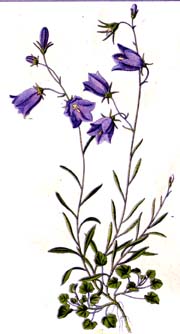|
Harebells A circumpolar native, this magick herb is found in North America as well as Northern Europe and the British Isles, where it has been grown since the Middle Ages. There it is strongly connected to the Good Folk, like many bell-shaped flowers, and people did not dig it out of their gardens in order not to offend them. The Victorians believed that fairies slept in the bells or used them as goblets for dew. At one time it was said that if a maiden counted the harebells she saw three times as the sun rises or as the dew falls, she would see Fairies, to whom she should curtsy three times to acquire their good wishes. According to Cunningham, someone wearing the flowers is unable to lie. But this flower didn't stop the fabled Ganconer, or Love Talker, an Irish Fairy, from using lies to connive lonely Irish maidens into lovemaking and then disappearing. Some folk in the British Isles believed that these flowers would ring to warn hares of nearby foxes (thus, they are harebells), but another rabbity connection is that witches utilized the sap of this plant to change themselves into hares, so consider this plant for shapeshifting. In North America, Haida Indians cautioned their children not to pick these flowers, or it would rain. And Navajo folk rubbed this plant on their bodies for protection while hunting or to keep off witchcraft. They also made a ceremonial fumigant from this plant to smudge a sick person against various ills, implying that these ills might have some supernatural cause. Harebells don't have a traditional planetary association, oddly enough, but because of their strong connection with magick and shapeshifting, their delicate, wiry stems, and their ability to quickly spread in certain situations, they could be Mercury. In the Victorian language of flowers, bluebells of Scotland signify grief, gratitude, or submission. The harebell is the emblem of the Macdonalds, and its flower provided a blue dye that was used to color the wool for tartans. It apparently had no medicinal uses in the British Isles (makes sense, considering pulling it up would attract negative attention from powerful beings), but the Cree and other Indians had no such qualms and used the root medicinally. The leaves of this wonderful cottage garden plant are edible in salads and boiled as a potherb. Butterflies, moths, and bees like the flowers. Harebells are also known as bluebells of Scotland, witches' thimbles, lady's thimbles, Fairy bells, Fairy thimbles, Devil's bells, Aul Man's bells, dead men's bells, heath bells, cuckoo's hood, milk ort, and in Gaelic, Méaracán gorm. Top
|
Campanula rotundifolia
Uses in Witchcraft & Magic:
Rain Magic
|
 Sow on moist planting medium and then gently press in, but don't cover
with soil, as the tiny seeds need light to germinate. For best results,
cold stratify for one month, then move to room temperature to germinate in a
staggered fashion over 4 weeks (or try Outdoor Treatment). Transplant outside when the
round-leaved seedlings are two inches across to full sun/partial shade.
This perennial is hardy to zone 3 (-40F/-40C) and likes rocky areas
near water. The plant develops a rosette of leaves the first year and
then puts up wiry black stalks from 6-12"/15-30cm high that have
several flowers each. The flowers appear June-September; blossoms are
usually blue or lavender with occasional white or pink ones. You can
propagate this plant by dividing clumps every few years, but it can
also become very aggressive in some gardens and spread through seed
and/or creeping roots.
Sow on moist planting medium and then gently press in, but don't cover
with soil, as the tiny seeds need light to germinate. For best results,
cold stratify for one month, then move to room temperature to germinate in a
staggered fashion over 4 weeks (or try Outdoor Treatment). Transplant outside when the
round-leaved seedlings are two inches across to full sun/partial shade.
This perennial is hardy to zone 3 (-40F/-40C) and likes rocky areas
near water. The plant develops a rosette of leaves the first year and
then puts up wiry black stalks from 6-12"/15-30cm high that have
several flowers each. The flowers appear June-September; blossoms are
usually blue or lavender with occasional white or pink ones. You can
propagate this plant by dividing clumps every few years, but it can
also become very aggressive in some gardens and spread through seed
and/or creeping roots.